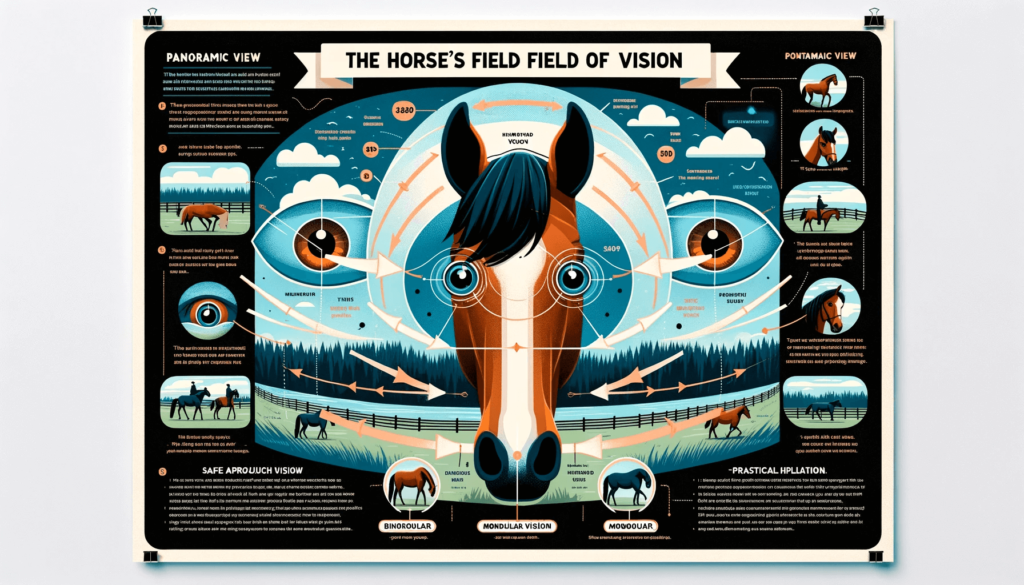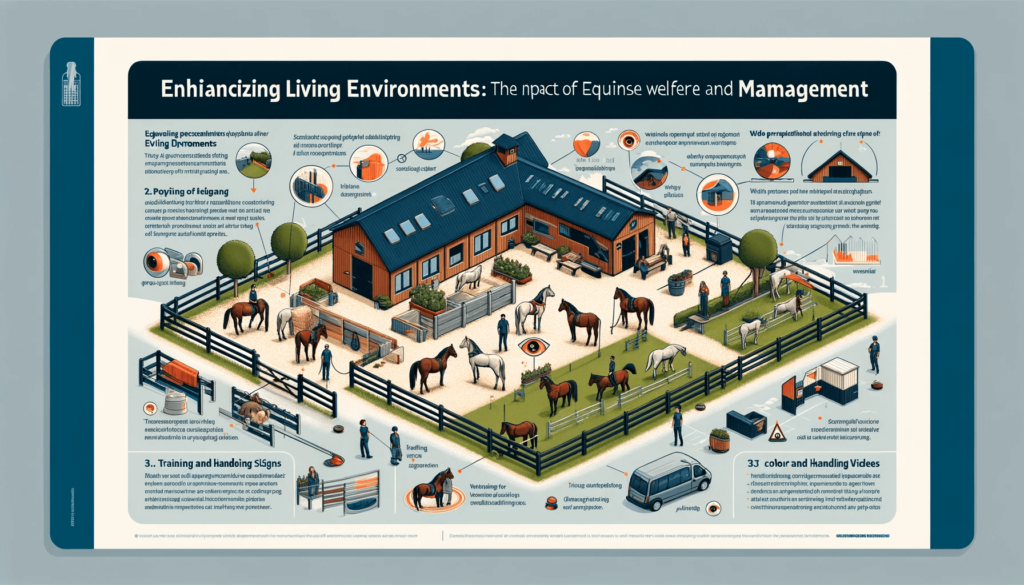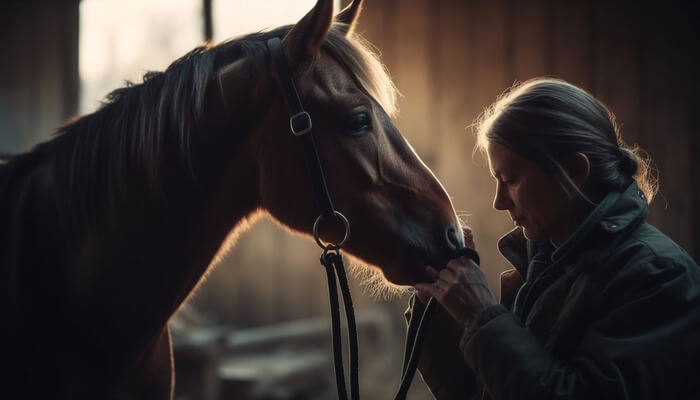Introduction:
The enigmatic gaze of a horse might seem to hold centuries of wild prairies and battles, yet there’s more to equine eyesight than romantic musings. Horse vision is a complex subject that intertwines with their evolutionary history, affecting their behavior, training, and welfare.
This article delves into the science behind how horses see the world, offering a blend of veterinary science, practical insights for horse handlers, and curious facts for equine enthusiasts.
Read More: Horse Lameness: Causes, Diagnosis, & Management
Evolutionary Adaptations of Equine Eyesight
Horses, majestic creatures that they are today, owe much of their survival to their ancestors who roamed the ancient plains. Over millions of years, horses have undergone a plethora of evolutionary changes, but one of the most pivotal for their survival has been the adaptation of their eyesight. Their eyes have evolved to become the largest of any land mammal, a testament to the importance of vision in their day-to-day lives.
Originally creatures of open landscapes, horses needed to detect motion from great distances, to spot predators and take flight. This evolutionary pressure sculpted their eyes to have a high density of motion-detecting cells. Moreover, the positioning of their eyes on the sides of their head grants them a nearly 350-degree field of vision, allowing them to monitor for threats while grazing.
Their retinas are also adapted for a life on the run. The horizontal streak of densely packed ganglion cells provides a panoramic view of the horizon — an essential feature for prey that need to be acutely aware of their surroundings. This adaption means that even when their head is down during feeding, they maintain a clear view across the plains, ready to bolt at the first sign of danger.
Read More: Fastest Horse in the World: A Gallop Through Time and Records
The Horse’s Field of Vision: A Panoramic Perspective

Horse vision is markedly different from human vision. Due to the placement of their eyes, horses have an expansive field of vision. They can see nearly 360 degrees around them, with a small blind spot directly in front and behind them. This panoramic vision allows horses to see predators and other dangers from almost all angles, reducing the chances of an ambush.
Their dual-purpose vision consists of both binocular and monocular vision. Binocular vision, where both eyes work together, provides depth perception and is used for seeing objects in front of them, like the ground when jumping a hurdle. Monocular vision allows them to process information from each eye separately, effectively giving them a split screen of their environment on either side. This means they can keep an eye out for predators while independently focusing on foraging or interacting with herd members.
Understanding a horse’s field of vision is critical for handlers, as it explains why horses may react suddenly to stimuli that humans are completely unaware of. Approaching a horse from its side, particularly along its shoulder, is less likely to startle the animal, whereas coming in from directly behind or in front can lead to a surprise for both the horse and human.
Read More: Exploring Careers with Horses: What Jobs Involve Horses?
Color Perception in Horses: What Do They Really See?
For years, the myth persisted that horses were completely color-blind, seeing the world in shades of gray. However, modern research has debunked this, revealing that horses do indeed perceive color, though not as vividly as humans do. Horses are dichromatic, meaning they have two types of cone cells in their eyes for detecting color, compared to the three types that humans possess.
Their color vision is similar to that of humans with red-green color blindness. Horses are good at distinguishing blues and greens, but they may have difficulty differentiating between colors that contain red. For example, a bright orange cone may appear as a softer green, while a red apple might not stand out much against green grass.
This understanding has practical implications in training and managing horses. Using colors that horses can easily distinguish may aid in their learning and performance. For instance, using blue or green hues in jump poles can help horses discern them better against the background, potentially improving their jumping performance and safety.
Read More: Are Horses Ruminants? Understanding Equine Digestion
Night Vision: How Horses See in the Dark
The equine ability to navigate their environment does not end when the sun goes down. Horses possess several adaptations that enable them to see in conditions of low light, giving them a significant advantage after dusk. Their large eyes maximize the amount of light entering the eye, which is essential for night vision. The retina of a horse’s eye is rich with rods, the photoreceptor cells sensitive to low-light conditions. These rods outnumber the cones responsible for color vision, which explains why horses can see better in the dark than they can discern colors.
Additionally, horses have a structure called the tapetum lucidum, a layer of tissue situated behind the retina that reflects visible light back through the retina, increasing the light available to the photoreceptors. This structure is what gives animals their distinctive eyeshine when caught in a light at night. The reflected light enhances their ability to see in the dark, although it is thought to reduce the sharpness of their image.
Even with these adaptations, a horse’s night vision is not perfect. While they can see better than humans in low light, they need a moment to adjust when moving from light to dark areas or vice versa. This adjustment period is something horse handlers need to be mindful of, ensuring they allow their horses to adapt when transitioning between different lighting conditions.
Read More: Strangles in Horses: Symptoms, Treatment, and Prevention
The Role of Monocular and Binocular Vision
The positioning of a horse’s eyes grants them a unique visual system that utilizes both monocular and binocular vision. Monocular vision refers to the use of one eye independently, which for horses is necessary for scanning their environment. Each eye can cover a field of nearly 180 degrees, which allows horses to monitor their surroundings for threats and opportunities with a range that humans can’t achieve without turning their heads.
Binocular vision, on the other hand, is when both eyes are used together, focusing on the same scene to provide depth perception. Horses have a relatively narrow binocular field that covers approximately 65 degrees of their total vision, primarily in front of them. This is the vision they use for activities that require depth perception, such as jumping obstacles or gauging distances.
These two types of vision are vital for a horse’s interaction with their environment. Monocular vision keeps them alert to the broader world, while binocular vision allows them to focus on specific tasks and gauge complex spatial relationships.
Read More: When Horses Reach Full Size: A Guide to Equine Growth
The Blind Spots of Equine Vision
Despite a horse’s wide field of vision, there are areas where their vision is limited — known as blind spots. Due to the lateral placement of their eyes, horses cannot see directly behind them. This rear blind spot extends from the tail up over the back, meaning anything that approaches from directly behind is unseen. They also have a small blind spot directly in front of them, close to their body and below their head.
These blind spots are critical to remember when working with horses to avoid startling them. A horse can react unpredictably if something or someone enters these blind spots unexpectedly. This is why it’s important to approach a horse at an angle where they can see you with their peripheral vision, usually at the shoulder. When working around a horse, it’s advisable to keep a hand on their body when moving from side to side to maintain a physical connection that signals your position.
Read More: Why Do Horses Like Sugar Cubes
How Vision Affects Equine Behavior
Vision plays a pivotal role in equine behavior, influencing everything from a horse’s interactions with its environment to its responses to training. The horse’s wide field of vision allows for early detection of predators or dangers, and their visual acuity can determine how they navigate through their surroundings. For example, a horse might shy away from an object not because the object is inherently frightening, but because it appears suddenly within their field of view or is difficult for them to see clearly.
Moreover, a horse’s depth perception, which relies on their binocular vision, can affect how they approach jumps or obstacles. A horse’s reluctance to approach a jump could be due to a lack of clarity in perceiving the distance or height of the obstacle. Additionally, the horse’s ability to detect slight movements can explain their skittishness in situations where humans might see no cause for alarm.
Understanding how vision influences behavior can help handlers and riders predict and mitigate potentially risky situations. It can also inform more compassionate training practices, taking into account the natural inclinations of a horse’s sight-driven responses.
Read More: What Temperature is Too Hot for Horses to Be Outside
Training with Horse Vision in Mind
Training horses effectively requires an understanding of their visual perceptions. Trainers should recognize the areas of sharp vision and blind spots to approach and interact with horses in a way that minimizes stress or fear. Knowing that horses have a wide field of vision but poor depth perception, trainers can introduce new objects from a distance, allowing the horse to examine them safely with their monocular vision before approaching with their binocular vision for close-up inspection.
When setting up training environments, objects and barriers should be placed where horses can easily see them, considering their color perception abilities. Equipment used should be in a color range that horses can distinguish clearly. Jumps and poles might be painted in contrasting colors to make them more visible against the background.
Furthermore, training should also include desensitization to sudden movements within the horse’s peripheral vision to reduce spooking and to build confidence. By being mindful of a horse’s visual perspective, trainers can create a training regimen that is aligned with the horse’s natural capabilities, making learning more intuitive for the horse.
Vision Problems and Disorders in Horses
Equine vision disorders can vary from minor issues to those that significantly impact a horse’s quality of life. Common problems include cataracts, which cloud the lens and reduce vision; uveitis, an inflammation that can lead to pain and vision loss; and glaucoma, an increase in eye pressure that can be painful and cause serious vision impairment.
Congenital conditions, such as stationary night blindness, can also occur in horses. Such disorders affect a horse’s ability to see in low-light conditions and can be particularly challenging for animals that rely heavily on their night vision. Other issues like corneal scratches or abrasions from dust, wind, or injury can impair vision temporarily and, if not treated promptly, can lead to more severe complications.
Early detection and treatment of these conditions are crucial. Owners and handlers need to be observant for signs of eye problems, such as cloudiness, redness, tearing, or the horse behaving unusually like being hesitant to enter dark areas or refusing jumps.
Advances in Equine Ophthalmology
The field of equine ophthalmology has seen considerable advances, improving the diagnosis and treatment of eye conditions in horses. Modern diagnostic tools, like ocular ultrasound and advanced imaging techniques, allow for more detailed examination of the eye’s structures, leading to better treatment plans.
Therapeutic options have expanded with the advent of new medications and surgical techniques. Laser surgery, for instance, can treat certain types of glaucoma and cataracts more effectively than ever before. Corneal grafting and other sophisticated procedures can repair damage that once might have led to blindness.
Preventive care has also improved, with better understanding of the importance of UV protection for horses in bright environments and the development of fly masks that protect the eyes from debris and insects while allowing for clear vision.
Innovations in genetics are also offering solutions, with research into hereditary conditions leading to better breeding practices to reduce the incidence of congenital eye issues. As veterinary ophthalmology continues to evolve, the future for managing and treating equine vision problems looks increasingly bright, ensuring better care and a higher quality of life for these valued animals.
Enhancing Equine Welfare: The Impact of Visual Perception on Horse Care and Management

Optimizing Living Environments for Horses
Understanding a horse’s vision is crucial in designing stables and paddocks. By considering their wide field of vision and sensitivity to movement, we can create spaces that are comforting and less stressful for horses. This includes the strategic placement of walls, windows, and objects in their living spaces to accommodate their panoramic view and reduce chances of surprise or fear.
Training and Handling Adaptations
Knowledge of how horses perceive their environment significantly influences training and handling methods. Recognizing their blind spots leads to safer approaches and interactions, reducing the likelihood of startling the horse. Training materials and methods can also be adapted to cater to their color perception abilities, thereby enhancing their learning experiences and performance in various equine activities.
Early Detection and Prevention of Vision-Related Issues
An in-depth understanding of equine vision helps in early detection of behavioral changes that might signify vision problems. Regular observation and awareness of how vision impacts their behavior enable handlers and veterinarians to identify and address vision-related issues promptly. This proactive approach not only ensures the well-being of the horse but also contributes to the longevity and quality of their life in human care.
Conclusion:
Horse vision is an integral aspect of their survival and daily interactions. By understanding how horses see, humans can create safer, more harmonious environments for them. This article has illuminated the nuances of equine vision, from the basic anatomy to complex behaviors influenced by sight.
As our knowledge of equine ophthalmology continues to expand, so does our ability to provide better care and develop deeper bonds with these magnificent animals.
FAQs:
Can horses see colors?
Yes, horses can see colors, but their color perception is limited compared to humans. They can distinguish some colors, especially in the blue and green spectrum.
Why is it important to know a horse’s blind spots?
Knowing a horse’s blind spots can prevent startling them and reduce the risk of injury to both the horse and handler. It is essential for safe riding and handling practices.
Do horses have good night vision?
Horses have relatively good night vision due to the large size of their eyes and the structure of their retinas, allowing them to see better than humans in low-light conditions.
What kind of vision problems can horses have?
Horses can suffer from cataracts, glaucoma, uveitis, and retinal diseases, among other eye problems. Regular check-ups by a veterinarian can help catch and treat these issues early.
How can horse trainers use knowledge of equine vision in their work?
Trainers can use this knowledge to approach horses from angles where they are visible, use training aids that are easily seen by horse vision, and design courses and environments that are safe and understandable for horses.
